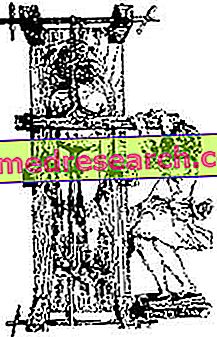Generality
Attention deficit hyperactivity disorder (ADHD) is a neuropsychic disorder that affects child and adolescent development.
This condition is characterized by:
- Obvious levels of inattention ;
- Hyperactivity (excessive, persistent and continuous motor activity);
- Difficulty in controlling behavioral and verbal impulses .
The causes of attention deficit hyperactivity disorder are not yet fully known, but the origin of the disorder appears to depend on the combination of environmental, social, behavioral, biochemical and genetic factors.

The treatment of ADHD is based on behavioral therapies and psycho-educational interventions. In some cases, to reduce the symptoms and improve the dysfunctions that the condition entails, these approaches are associated with the use of specific drugs, including methylphenidate and atomoxetine.
What is ADHD
Attention deficit hyperactivity disorder is one of the most common developmental age disorders (childhood and adolescence).
ADHD affects about 3-5% of children and can persist even into adulthood, compromising social, academic and professional functioning.
Attention deficit hyperactivity disorder is typically characterized by:
- Attention deficit;
- Excessive, persistent and continuous motor activity (hyperactivity);
- Behavioral and verbal impulsiveness.
Children with attention deficit hyperactivity disorder seem to be always busy in some activity, even if they often do not complete it, because they are continuously distracted by new stimuli. The tendency to not listen and / or excessive motor activity leads to restlessness, difficulty sitting and an inability to wait for one's turn.
These manifestations (hyperactivity, impulsivity and inattention) are nothing more than the consequence of the child's inability with ADHD to control their responses to the stimuli deriving from the environment, and to focus their attention on a single specific task.
Causes
Attention deficit hyperactivity disorder does not recognize a single specific cause. In fact, the origin of the disorder seems to depend on the interaction of various environmental, social, behavioral, biochemical and genetic factors.
In the etiology of ADHD, in particular, the expression of some genes that regulate the level of dopaminergic and noradrenergic neurotransmitters seems to be implicated. These alterations mainly affect the functions performed by specific areas of the brain, which regulate attention (pre-frontal cortex, part of the cerebellum and some basal ganglia, ie clusters of nerve cells located deep in the brain).
Attention deficit hyperactivity disorder tends to recur within the same family and often occurs in association with other behavioral or conduct disorders.
Environmental factors seem to involve cigarette smoking and alcohol abuse in pregnancy, low neonatal weight (or premature birth) and neurological damage reported after obstetric or cranial trauma.
A greater risk of developing ADHD may also depend on congenital infections and exposure to paints, pesticides, lead and certain food additives (dyes and preservatives).
Symptoms and complications
Attention deficit hyperactivity disorder begins in childhood and pre-adolescence. On average, the presentation of the disorder occurs before the age of 7 (note: according to the DSM-5 diagnostic criteria, it is necessary that some events occur within 12 years of age).
The symptomatology of ADHD is represented by inattention, hyperactivity and impulsivity, more evident than expected for a child in the pre-school age of equal development.
Depending on whether one of these characters prevails, it is possible to distinguish three variants of the disorder :
- Inattentive (ie with predominant inattention);
- Hyperactive-impulsive ;
- Combined form .
In any case, the manifestations are excessive and inconsistent due to age or level of development .
Attention deficit hyperactivity disorder influences academic performance, the ability to develop appropriate social behavior, and thinking and reasoning strategies. The dysfunctions of various nature (social, scholastic and family) favor the development of agitated, oppositional and provocative behaviors in the child.

Difficulties in social and emotional relationships can persist into adulthood.
Characteristic characteristics and behaviors
- Attention deficit - Children with attention deficit hyperactivity disorder have difficulty concentrating and are easily distracted. Inattention involves the forgetting of things, the frequent passage from one activity to another and the ease of getting bored after a few minutes.
The attention deficit is also evident in the inability to follow a conversation for a prolonged time and in the difficulty of learning, following instructions or completing a required task. The child forgets things, seems absent and gets bored quickly for an activity, so he frequently goes on to something else.
- Hyperactivity - In the context of ADHD, motor activity is excessive and involves a series of behaviors such as difficulties in sitting at school desks or during meals, restlessness and extreme talkativeness. Children with attention deficit hyperactivity disorder move continuously and find it difficult to stay still, touch everything they find or play with anything.
- Impulsiveness - Children with ADHD can be very impatient and have difficulty waiting for their turn, show their emotions without restraint and do not reflect on the consequences of their gesture or their words. Other disorders that indicate impulsiveness are excesses of anger and aggression.
See also: ADHD symptoms »
ADHD in adults
During childhood, typical ADHD behaviors interfere with many aspects of life, such as school, family relationships and social life. Usually, these disorders are maintained even during adolescence. Over time, symptoms may change in intensity. In some cases, the manifestations associated with attention deficit hyperactivity disorder can be attenuated.
Other ADHD patients, on the other hand, can continue to have interpersonal problems, tend to abuse alcohol or drugs and develop personality disorders. Moreover, in adulthood, disorganization, impulsiveness, emotional lability and poor tolerance to stress can occur.
Associated disorders
Attention deficit hyperactivity disorder may be accompanied by other disorders, which can significantly complicate diagnosis and treatment.
The conditions most commonly related to ADHD are:
- Oppositional-provocative disorder and conduct disorder (characterized by antisocial behavior);
- Specific learning disorders (dyslexia, dysgraphia, etc.);
- Sleep disorders.
Less frequently, attention deficit hyperactivity disorder is associated with:
- Borderline personality disorder;
- Mood disorders (especially bipolar and major depression);
- Anxiety disorders;
- Obsessive-compulsive disorder.
Diagnosis
The diagnosis of ADHD is established by the pediatrician and / or child psychiatrist after collecting information about the child and his behavior in different situations, provided by multiple and diversified sources (such as parents and teachers).
The manifestations underlying the diagnosis of ADHD are inattention, hyperactivity and impulsiveness. These must be distinguished by severity, intensity and persistence, by normal and occasional episodes of reduced concentration and physiological vivacity of many children. Furthermore, these symptoms could be the consequence of a different pathology compared to attention deficit hyperactivity disorder. For this reason, the doctor must exclude the presence of other diseases, situations or events that can cause temporary and potentially treatable behaviors that mimic the symptoms of ADHD (for example: hearing problems, learning difficulties, anxiety or depression etc.) .
In addition to assessing levels of inattention, hyperactivity and impulsivity, therefore, certain requirements must be met to establish the diagnosis of ADHD.
In particular, it is important that the key symptoms of the syndrome (attention deficit, hyperactivity and impulsivity) are present for at least six months, appear before the age of seven and occur in more than one context of the child 's life (eg . school, family and society).
Furthermore, to carry out the diagnosis of ADHD it is always necessary to assess the child's cognitive level and ability to communicate.
In adults, ADHD can manifest itself with more varied symptoms, but to make the diagnosis it is necessary to identify the presence of the disorder in childhood.
Therapy
Attention deficit hyperactivity disorder is a chronic condition that can be addressed by different approaches, such as drugs, psychotherapy, education, lifestyle changes or a combination of them.
The goal of these interventions is to reduce the symptoms of ADHD and improve the dysfunctions that the condition entails. The ideal treatment for attention deficit hyperactivity disorder takes place on several fronts, involving not only the patient himself, but also school and family.
Although the picture can improve over time, it is important to intervene early to avoid the development of persistent affective-relational deficits, conduct disorders or learning delays.
Behavioral and psychological therapies
The treatment of ADHD is based on behavioral and psycho-educational therapies.
These interventions include, for example, maintaining a daily schedule, setting small achievable goals and safeguarding concentration, minimizing distractions and rewarding positive behavior. These strategies can be applied both by parents and by teachers who are included in the therapeutic path. The treatment therefore aims to reduce the dysfunctional behavior of the child with ADHD.
Pharmacological treatment
In some cases, the use of specific drugs can be associated with behavioral therapies. It should be noted, however, that these medicines allow the symptoms of ADHD to be controlled as long as they are taken, but do not cure the disease . Furthermore, their treatment is not recommended for preschool children, as the long-term effects of this treatment are not known.
The most commonly used drugs include methylphenidate . This drug is a stimulant of the amphetamine group, able to modulate dopamine reuptake by neuronal synapses; the state of hyperactivity due to the transmission of this neurotransmitter is thus attenuated.
Another drug used to treat ADHD is atomoxetine ; this works by blocking the re-uptake of norepinephrine and, to a lesser extent, serotonin.
During the course of drug therapy, regular monitoring of the patient with ADHD is necessary to verify adherence to the treatment protocol, the disappearance of the main symptoms and any adverse effects.



